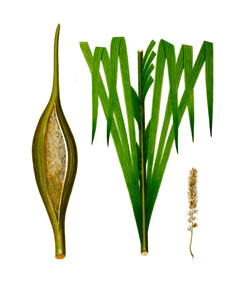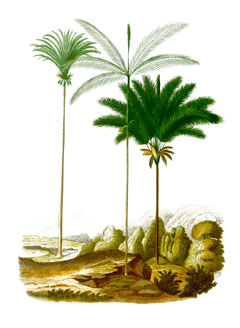 |
|
https://edibleplants.org/ |
 |
| https://edibleplants.org/ |
Translate this page:
Summary
Inaja or Maripa Palm (Attalea maripa) is a tall palm that grows up to 20 m tall with trunk diameter of up to 100 cm. It is native to South America and Trinidad and Tobago. The oil obtained from the kernel of the seeds has medicinal purposes. It is used through rubbing as relief from rheumatism. It can also be used in cooking. The large and brown or yellow fruit is edible and is used to make a drink. Endosperm of the seed is edible as well and often toasted. Further, the apical bud is eaten as vegetable. The pulp of the fruit yields oil for biodiesel production. Mature leaves are used for thatching while young leaves are used as weaving material. A. maripa can be used as a pioneer species due to its characteristics.
Physical Characteristics

 Attalea maripa is an evergreen Tree growing to 15 m (49ft) by 15 m (49ft) at a medium rate.
Attalea maripa is an evergreen Tree growing to 15 m (49ft) by 15 m (49ft) at a medium rate.
See above for USDA hardiness. It is hardy to UK zone 10. The flowers are pollinated by Bees, insects.
Suitable for: light (sandy), medium (loamy) and heavy (clay) soils and prefers well-drained soil. Suitable pH: mildly acid, neutral and basic (mildly alkaline) soils and can grow in saline soils.
It can grow in semi-shade (light woodland) or no shade. It prefers moist soil. The plant can tolerates strong winds but not maritime exposure.
UK Hardiness Map
US Hardiness Map
Synonyms
Attalea cryptanthera Wess.Boer Attalea macropetala (Burret) Wess.Boer Attalea regia (Mart.) Wess.Boe
Plant Habitats
Edible Uses
Edible Parts: Fruit Oil Seed
Edible Uses: Condiment Drink Milk Oil
Edible portion: Fruit, Kernel, Drink, Palm heart, Cabbage, Oil, Nut. Fruit - raw[ 416 ]. A succulent, aromatic, almost fibreless pulp with a sweet, pleasant flavour[ 416 ]. It is used to make a drink[ 317 ]. The fruit is up to 5cm long[ 416 ]. The mesocarp provides a 'milk' for drinking[ 200 ]. Seed - the endosperm is toasted[ 317 ]. An oil extracted from the seed is used for cooking[ 317 ]. The outer husk of the fruit makes a kind of salty flour used to flavour food. The apical bud is eaten as a vegetable[ 317 ]. Eating this bud will effectively kill the tree since it is unable to produce side shoots[ 317 ].
References More on Edible Uses
Medicinal Uses
Plants For A Future can not take any responsibility for any adverse effects from the use of plants. Always seek advice from a professional before using a plant medicinally.
Antirheumatic
An oil obtained from the seeds is rubbed onto rheumatic areas of the body in order to bring relief[ 348 ].
References More on Medicinal Uses
The Bookshop: Edible Plant Books
Our Latest books on Perennial Plants For Food Forests and Permaculture Gardens in paperback or digital formats.

Edible Tropical Plants
Food Forest Plants for Hotter Conditions: 250+ Plants For Tropical Food Forests & Permaculture Gardens.
More

Edible Temperate Plants
Plants for Your Food Forest: 500 Plants for Temperate Food Forests & Permaculture Gardens.
More

More Books
PFAF have eight books available in paperback and digital formats. Browse the shop for more information.
Shop Now
Other Uses
Beads Containers Oil Pioneer Thatching Wood
Other uses rating: Very High (5/5). Agroforestry Uses: The plant shows pioneer characteristics[ 419 ]. It regenerates vigorously after being cut down and the dormant seeds germinate after forest fires or the clearing of forested areas[ 419 ]. These traits make it an excellent choice as a pioneer species for restoring native woodland and especially, when taking into account all the plant's uses, for establishing a woodland garden[ K ]. Other Uses The fruit is a rich source of oil[ 314 ]. It is currently being investigated for its suitability for biodiesel production[ 314 ]. The leaves are used for thatching[ 317 , 768 ]. The young leaves are made into mats and pack baskets[ 317 ]. They are used as a heavy-duty weaving material[ 200 ]. The woody bract is used as a container[ 200 ]. The seeds are used to make jewellery[ 757 ]. The wood is moderately heavy, hard, resistant, of low durability[ 419 ]. The whole trunks are used locally for rustic constructions such as stays, rafters and laths[ 419 ].
Special Uses
Carbon Farming Food Forest
References More on Other Uses
Cultivation details
Management: Standard Regional Crop Staple Crop: Oil
A plant of the lowland, moist tropics. Plants are frost sensitive[ 314 ]. Requires a sunny position in a well-drained soil[ 314 ]. Plants are usually found in more open areas in the wild but also succeed in the dappled shade of the forest[ 419 ]. Found in a range of soils from sandy to clayey[ 419 ]. Plants have a moderate rate of growth[ 419 ]. Production: The palms start to flower in the tenth year. They can live for 200 years. It produces 2-6 fruiting clusters each year. The kernel is 66% oil. In Bolivia there are an average of 182-211 trees per hectare. Fruit yields are 2456-2624 kg per hectare.
Carbon Farming
-
Management: Standard
Plants grow to their standard height. Harvest fruit, seeds, or other products. Non-Destructive management systems.
-
Regional Crop
These crops have been domesticated and cultivated regionally but have not been adopted elsewhere and are typically not traded globally, Examples in this broad category include perennial cottons and many nuts and staple fruits.
-
Staple Crop: Oil
(0-15 percent protein, 16+ percent oil). Some of these are consumed whole while others are exclusively pressed for oil. Annuals include canola, poppyseed, maize, cottonseed, sunflower, peanut. Perennials include high-oil fruits, seeds, and nuts, such as olive, coconut, avocado, oil palm, shea, pecan, and macadamia. Some perennial oil crops are consumed whole as fruits and nuts, while others are exclusively pressed for oil (and some are used fresh and for oil).
References Carbon Farming Information and Carbon Sequestration Information
Temperature Converter
Type a value in the Celsius field to convert the value to Fahrenheit:
Fahrenheit:
The PFAF Bookshop
Plants For A Future have a number of books available in paperback and digital form. Book titles include Edible Plants, Edible Perennials, Edible Trees,Edible Shrubs, Woodland Gardening, and Temperate Food Forest Plants. Our new book is Food Forest Plants For Hotter Conditions (Tropical and Sub-Tropical).
Shop Now
Plant Propagation
Seed - best sown as soon as it is ripe in a nursery bed or individual containers[ 419 ].
Other Names
If available other names are mentioned here
Inaja or Maripa Palm (Attalea maripa). Other Names: Curete, Huacava, Cusi, Incham, Kokerite, Anaja, Guichire, Kukarit, Inayuga, Cucurito, Cucurite Palm, Inayuga, Shapajilla, Koheri Palm.
Native Range
SOUTHERN AMERICA: Trinidad and Tobago (Trinidad), French Guiana, Guyana, Suriname, Venezuela (Bolívar, Amazonas, Monagas, Sucre, Delta Amacuro), Brazil (Acre, Amazonas, Maranhão, Mato Grosso, Mato Grosso do Sul, Pará, Rondônia), Bolivia (El Beni, Pando, Santa Cruz), Colombia (Meta, Caquetá, Putumayo, Amazonas, Guainía, Vaupés, Vichada, Guaviare), Ecuador (Napo), Peru (Loreto, Madre de Dios, Ucayali)
Weed Potential
Right plant wrong place. We are currently updating this section.
Please note that a plant may be invasive in one area but may not in your area so it's worth checking.
None Known
Conservation Status
IUCN Red List of Threatened Plants Status : This taxon has not yet been assessed.

Growth: S = slow M = medium F = fast. Soil: L = light (sandy) M = medium H = heavy (clay). pH: A = acid N = neutral B = basic (alkaline). Shade: F = full shade S = semi-shade N = no shade. Moisture: D = dry M = Moist We = wet Wa = water.
Now available:
Food Forest Plants for Mediterranean Conditions
350+ Perennial Plants For Mediterranean and Drier Food Forests and Permaculture Gardens.
[Paperback and eBook]
This is the third in Plants For A Future's series of plant guides for food forests tailored to
specific climate zones. Following volumes on temperate and tropical ecosystems, this book focuses
on species suited to Mediterranean conditions—regions with hot, dry summers and cool, wet winters,
often facing the added challenge of climate change.
Read More
Expert comment
Author
(Aubl.) Mart.
Botanical References
Links / References
For a list of references used on this page please go here
A special thanks to Ken Fern for some of the information used on this page.
Readers comment
| Add a comment |
|
If you have important information about this plant that may help other users please add a comment or link below. Only comments or links that are felt to be directly relevant to a plant will be included. If you think a comment/link or information contained on this page is inaccurate or misleading we would welcome your feedback at [email protected]. If you have questions about a plant please use the Forum on this website as we do not have the resources to answer questions ourselves.
* Please note: the comments by website users are not necessarily those held by PFAF and may give misleading or inaccurate information.
To leave a comment please Register or login here All comments need to be approved so will not appear immediately.
|
|